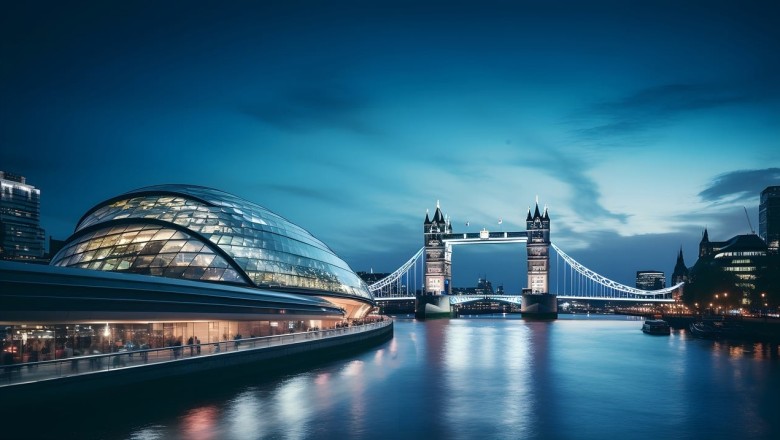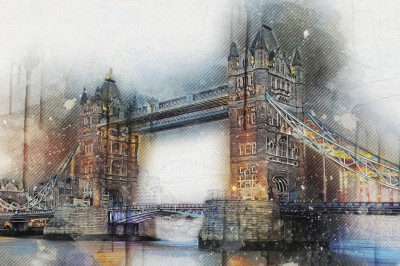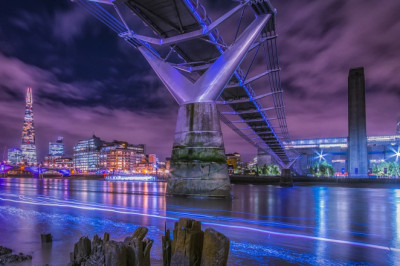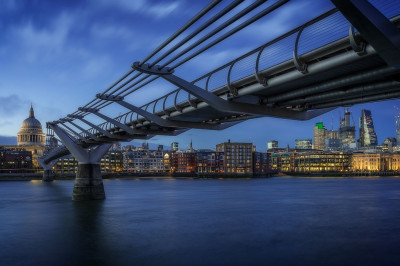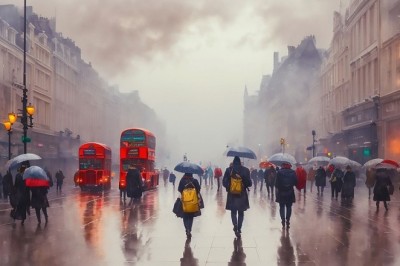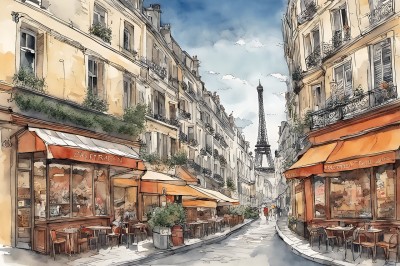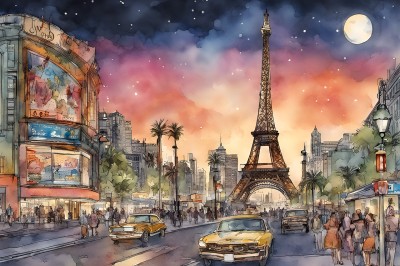London's Enchanting Appeal A Tapestry of History and Modernity
London, a city with a history stretching back to Roman times, is a mesmerizing blend of the ancient and the contemporary. Its streets echo with stories from centuries past, yet pulse with the vibrant energy of a modern metropolis. The city's architecture is a visual feast, where iconic landmarks like the Tower of London and Westminster Abbey stand in harmony with the sleek lines of The Shard and the Gherkin.
Cultural Melting Pot
The city's charm is amplified by its cultural diversity. London is a melting pot where over 300 languages are spoken, and every corner of the globe is represented, offering an eclectic mix of cuisines, fashion, music, and art. This diversity is celebrated throughout the city's neighborhoods, from the curry houses of Brick Lane to the vibrant markets of Brixton.
Royal Heritage and Pageantry
London's royal heritage adds a layer of splendor to its appeal. The grandeur of Buckingham Palace, the ceremonial Changing of the Guard, and the regal parks and palaces scattered across the city are constant reminders of the living history and tradition that Londoners cherish.
Artistic and Literary Haven
The city has long been a haven for artists and writers, with its world-class museums, galleries, and theaters. The West End's glittering stages, the literary history of Bloomsbury, and institutions like the British Museum and Tate Modern are testaments to London's status as a global cultural capital.
Green Spaces and Serenity
Amidst the urban hustle, London offers serene escapes in its many parks and gardens. The Royal Parks, including Hyde Park and Regent's Park, provide tranquil green spaces where visitors can unwind, while the hidden gems like the Chelsea Physic Garden offer a peaceful retreat.
A Hub of Innovation and Creativity
London is at the forefront of innovation and creativity, with a dynamic start-up scene and a reputation for fashion and design. Events like London Fashion Week and the London Design Festival showcase the city's forward-thinking spirit and its role as a trendsetter on the world stage.
Unmatched Shopping and Gastronomy
From the luxury boutiques of Bond Street to the bustling stalls of Camden Market, London's shopping experience is unrivaled. Gastronomy in London is equally impressive, with Michelin-starred restaurants, historic pubs, and street food markets catering to every palate and preference.
A City of Festivals and Celebrations
Throughout the year, London bursts into celebration with festivals and events that reflect its vibrant cultural tapestry. The Notting Hill Carnival, Chinese New Year, and Diwali in Trafalgar Square are just a few examples of the city's festive spirit.
An Epicenter of Learning and Scholarship
Home to prestigious universities like Imperial College and the London School of Economics, London is a hub of learning and scholarship. The city's libraries, research institutions, and academic events draw students and thinkers from around the world.
Connectivity and Accessibility
London's extensive public transport network, including the iconic London Underground, makes exploring the city's charm effortless. The city's five airports and status as a transport hub make it an accessible destination for international travelers.
Through its rich tapestry of history, culture, and innovation, London's enchanting appeal captivates the hearts of visitors and locals alike. It is a city where the past and future coexist, inviting everyone to discover its many layers and hidden treasures.
The Historic Majesty of the Tower of LondonA Fortress Steeped in History
The Tower of London's history spans over a millennium, with its foundation laid by William the Conqueror in Originally designed as a symbol of Norman power, the Tower has served various roles: royal palace, fortress, prison, and even a royal mint. Its architecture is a testament to its evolving functions, with the White Tower at its heart, an iconic example of Norman military architecture.
The Crown Jewels and Royal Regalia
Within the secure walls of the Tower, the Crown Jewels are a breathtaking collection of regalia, symbols of the British monarchy's pomp and ceremony. Visitors can marvel at over 23,000 gemstones, including the world-renowned Cullinan Diamond and the Imperial State Crown. The Jewel House, where these treasures are displayed, offers a glimpse into the opulence and grandeur of the monarchy.
The Tower's Role as a Prison
The Tower of London's reputation as a formidable prison is woven into the fabric of British history. It has housed a range of prisoners, from high-profile figures like Anne Boleyn and Sir Thomas More to the notorious Kray twins in the 20th century. The Beauchamp Tower, among others, still bears the inscriptions of those who were once held within its cold, stone walls.
The Yeoman Warders and Ravens
The Yeoman Warders, also known as Beefeaters, are the ceremonial guardians of the Tower. These iconic figures conduct tours, sharing tales of intrigue, imprisonment, and execution. Legend has it that the kingdom and the Tower will fall if the six resident ravens ever leave the fortress. The ravens' wings are clipped to ensure they remain, continuing the tradition and securing the fate of the Tower.
The Tower's Architecture and Expansions
Over the centuries, the Tower of London has undergone numerous expansions and renovations. The inner and outer curtain walls, the medieval Tower Green, and the Bloody Tower are just a few of the architectural highlights. Each addition tells a story of the monarchs who ruled and the Tower's adaptation to the needs of its time.
Ceremonies and Traditions
The Tower of London is home to time-honored ceremonies such as the nightly Ceremony of the Keys, a tradition of locking up the Tower that has been carried out every night for over 700 years. This ritual, along with others, continues to be a living link to the nation's heritage, observed with the same precision and reverence as it was centuries ago.
The Tower in Popular Culture
The Tower of London has captured the imagination of artists, writers, and filmmakers throughout the ages. It has been featured in numerous works of fiction, plays, and films, often depicted as a place of drama and mystery. Its presence in popular culture serves as a reminder of its enduring legacy and the fascination it holds for people around the world.
Exploring the Royal Wonders: Buckingham Palace and the Changing of the GuardBuckingham Palace: A Glimpse into Royal Life
Buckingham Palace is not only the official London residence of the British monarch but also a symbol of the UK's enduring monarchy and rich history. The palace has served as the administrative headquarters of the reigning monarch since the mid-19th century and is one of the few working royal palaces remaining in the world today.
Visitors can explore the 19 magnificent State Rooms, which are used for official events and receptions. These rooms are adorned with some of the greatest treasures from the Royal Collection, including paintings by Rembrandt, Rubens, and Van Dyck, exquisite examples of fine French furniture, and intricate English and French porcelain.
The palace's exterior is equally impressive, with the famous balcony where the royal family appears during major events, and the well-manicured gardens, which are the largest private gardens in London.
The Changing of the Guard: A Ceremonial Tradition
The Changing of the Guard is a must-see ceremony that epitomizes the pomp and circumstance of the British monarchy. This iconic event takes place at the forecourt of Buckingham Palace and involves a precise and elaborate exchange of duties between the Old Guard and the New Guard.
The ceremony is a display of military precision, pageantry, and music, and it is conducted by soldiers on active duty from the Foot Guards who are part of the Household Division. These guards are not merely ceremonial but also serve as professional soldiers.
Witnessing the Pageantry
To fully experience the Changing of the Guard, visitors should arrive early to secure a good viewing spot as the event attracts large crowds. The ceremony typically lasts about 45 minutes and includes the inspection of the troops by the Captain of the Guard, the band playing military music, and the actual handover of responsibilities.
The guards, dressed in traditional red tunics and bearskin hats, march to the accompaniment of a military band. The music played ranges from traditional marches to songs from popular culture, reflecting the modern face of the British Army.
Tips for Visitors
For those planning to witness the Changing of the Guard, it is advisable to check the schedule in advance as the ceremony does not take place every day and can be affected by weather or other events. The best spots for viewing are usually along the Buckingham Palace fence towards the Victoria Memorial or on the steps of the memorial itself.
Visitors should also be aware that security is tight around Buckingham Palace, and they should be prepared for potential bag searches and follow any instructions given by the police or security personnel.
Beyond the Ceremony
After the Changing of the Guard, visitors can explore the surrounding area, which includes other notable landmarks such as St. James's Park, one of London's oldest Royal Parks. The park offers a tranquil escape from the city bustle and provides excellent views of the palace and the ceremonial guards as they march along The Mall.
For those interested in delving deeper into the history and traditions of the British monarchy, guided tours are available that provide insights into the ceremony's significance and the role of the Household Division. These tours often include anecdotes and historical context that enrich the visitor's experience.
A Stroll Through Time: The British Museum and Its TreasuresThe British Museum: A Historical Overview
The British Museum, established in 1753, stands as a testament to human history, art, and culture. Its expansive collection spans over two million years of history and is a treasure trove of artifacts from around the world. As one of the world's oldest museums, it offers visitors an unparalleled glimpse into the past, with a diverse array of exhibits that showcase the breadth of human civilization.
Exploring the Ancient WorldThe Rosetta Stone
One of the museum's most famous artifacts, the Rosetta Stone, is a crucial key to understanding Egyptian hieroglyphs. Discovered in 1799, this granodiorite stele inscribed with a decree issued in Memphis, Egypt, in 196 BC, provided the necessary clues that allowed scholars to decipher ancient Egyptian writing for the first time.
The Egyptian Mummies
The museum's collection of Egyptian mummies draws visitors into the world of the pharaohs. The mummies, along with their intricately decorated sarcophagi, offer a fascinating insight into the burial practices and beliefs about the afterlife in ancient Egypt.
The Elgin Marbles
The Elgin Marbles, a collection of classical Greek marble sculptures, friezes, and figures, originally part of the Parthenon and other buildings on the Acropolis of Athens, are displayed in the museum. These pieces provide a window into ancient Greek art and architecture.
Treasures from the Middle EastThe Assyrian Lion Hunt Reliefs
The Assyrian Lion Hunt reliefs, from the North Palace of Ashurbanipal in Nineveh, are a powerful representation of royal power and the human struggle against nature. These detailed carvings date back to the 7th century BC and are a highlight of the museum's Middle Eastern collection.
The Oxus Treasure
The Oxus Treasure is a collection of about 180 surviving pieces of metalwork in gold and silver from the Achaemenid Persian period. These items, ranging from vessels to coins and jewelry, provide a glimpse into the wealth and craftsmanship of the Persian Empire.
Discoveries from AsiaThe Amaravati Sculptures
The Amaravati sculptures, hailing from a Buddhist stupa in Andhra Pradesh, India, are an exquisite example of ancient Indian art. Carved in the 1st to 3rd centuries AD, these sculptures depict the life of the Buddha and are an important record of early Buddhist iconography.
The Chinese Ceramics
The museum's extensive collection of Chinese ceramics showcases the evolution of Chinese pottery and porcelain. With pieces dating from the Neolithic period to the Qing dynasty, the collection highlights the artistry and technical skill of Chinese potters.
European EnlightenmentThe Enlightenment Gallery
The Enlightenment Gallery, housed in the King's Library, takes visitors back to the age of Enlightenment. This gallery displays objects collected during the 18th and 19th centuries, reflecting the era's quest for knowledge, understanding of the world, and the beginnings of modern museology.
The Museum Today: Engaging with the Public
The British Museum continues to engage with the public through educational programs, special exhibitions, and digital access to its collections. It remains a vital institution for learning, offering a unique experience to explore the interconnectedness of world cultures and the shared history of humanity.
The Iconic Landmark: Experiencing the London EyeA Brief History of the London Eye
The London Eye, also known as the Millennium Wheel, was erected in 1999 and officially opened to the public in March It was conceived as a temporary structure to celebrate the new millennium, but its popularity secured its status as a permanent fixture on the London skyline. The Eye was designed by architects Frank Anatole, Nic Bailey, Steve Chilton, Malcolm Cook, Mark Sparrowhawk, Julia Barfield, and David Marks.
The Design and Structure
Standing at an impressive height of 135 meters, the London Eye was the world's tallest cantilevered observation wheel at the time of its opening. It features 32 sealed and air-conditioned ovoidal passenger capsules, each representing one of London's 32 boroughs. The wheel rotates at a leisurely pace of about 0.6 miles per hour, allowing passengers to step on and off without the wheel needing to stop.
Booking Your Experience
Visitors are advised to book tickets in advance to avoid long queues, with the option to purchase standard or fast-track tickets for quicker access. There are also private capsule experiences available for special occasions or for those seeking a more intimate experience.
The 30-Minute Rotation
A complete rotation on the London Eye takes approximately 30 minutes, offering passengers ample time to soak in the panoramic views of London. From the top, one can see up to 40 kilometers on a clear day, with sights including the Houses of Parliament, St. Paul's Cathedral, Buckingham Palace, and the Shard.
Interactive Capsules and In-Capsule Experiences
Some capsules are equipped with interactive guides in several languages, providing information about the landmarks visible from the Eye. For an enhanced experience, visitors can opt for an in-capsule experience, which might include champagne, chocolate, or wine tasting, depending on the package selected.
Special Events and Seasonal Offerings
The London Eye hosts a variety of special events throughout the year, such as New Year's Eve fireworks, Valentine's Day couples' capsules, and Halloween-themed experiences. Seasonal offerings also include themed decorations and limited-time experiences that align with holidays and celebrations in the city.
Photography and Souvenirs
As a no-brainer for any tourist attraction, there are ample opportunities for photography, both of the Eye itself and from the capsules. Professional photographs are taken before boarding, and visitors can purchase these as souvenirs. There is also a range of London Eye-themed merchandise available at the gift shop.
Accessibility and Facilities
The London Eye is fully accessible to wheelchair users and offers dedicated capsules for those with mobility issues. There are also facilities such as restrooms and a café at the base of the Eye, ensuring that all visitor needs are catered for.
Environmental Commitment
The London Eye demonstrates a commitment to the environment, with initiatives in place to reduce its carbon footprint, such as energy-efficient lighting and recycling programs. It stands as a symbol of modern London, combining innovative design with a consciousness for sustainability.
The Heart of British Politics: A Tour of the Houses of Parliament and Big BenExploring the Iconic Structure
The Houses of Parliament, also known as the Palace of Westminster, stands as a symbol of British democracy and history. This Gothic Revival masterpiece, designed by architect Charles Barry and Augustus Pugin, is where the two houses of the Parliament of the United Kingdom—the House of Commons and the House of Lords—convene to debate and create laws. Visitors can marvel at the intricate stonework, the grandeur of its spires, and the impressive statues that adorn its exterior.
Big Ben: The Great Bell of Westminster
Big Ben is the nickname for the Great Bell of the clock at the north end of the Palace of Westminster, but it is often extended to refer also to the clock and the clock tower. The tower itself was renamed the Elizabeth Tower in 2012 to mark the Diamond Jubilee of Elizabeth II. The clock is a British cultural icon and one of the most prominent symbols of the United Kingdom.
Inside the Houses of Parliament
Upon entering the Houses of Parliament, visitors are greeted by opulent interiors, rich with political and cultural history. The Central Lobby serves as the heart of the building, with corridors leading to the Commons and Lords chambers. The House of Lords is adorned with red leather benches and a magnificent golden throne, while the House of Commons is known for its green benches and the Speaker's Chair. The intricate frescoes, wood carvings, and mosaic floors throughout the building reflect the grandeur of British politics.
The Westminster Hall
Westminster Hall, the oldest part of the Palace, has witnessed numerous historical events, including state trials, coronation banquets, and addresses by foreign dignitaries. Its impressive medieval timber roof, commissioned by Richard II in 1393, is one of the largest unsupported hammerbeam roofs in the world. The hall continues to play a central role in public life and is a must-see for those interested in the history and tradition of British politics.
Guided Tours and Public Access
Visitors can experience the Houses of Parliament through guided tours, which offer a deep dive into the building's history, architecture, and political significance. Tours may include visits to the Queen's Robing Room, the Royal Gallery, and the Lords and Commons chambers when they are not in session. For UK residents, there is also the opportunity to watch debates and committee hearings, providing a firsthand look at the British legislative process in action.
The Annual State Opening of Parliament
One of the most significant events in the parliamentary calendar is the State Opening of Parliament, which marks the formal start of the parliamentary session. This ceremonial event is characterized by the Queen's Speech, delivered from the throne in the House of Lords. Although attendance is by invitation only, tourists can witness the grand procession and the pomp and pageantry that accompany this historic occasion.
The Clock Tower Tour
For those interested in the mechanics and history of Big Ben, the Clock Tower tour offers an exclusive look at the clock mechanism and the chance to hear the Great Bell chime up close. Note that the tours are subject to restrictions and are not always available to the general public, so it is essential to check availability in advance.
The Role of the River Thames
The Houses of Parliament sit elegantly on the banks of the River Thames, a strategic location that has played a pivotal role in the site's defense and the city's development. The river provides a stunning backdrop for the building and offers a unique perspective for visitors taking riverboat cruises. The view of the palace from the Thames is a quintessential London experience, showcasing the blend of historical significance and natural beauty.
Engaging with Modern-Day Politics
For those looking to engage with contemporary political issues, the Houses of Parliament offer various educational programs, talks, and workshops. These events provide insights into the current political climate and the workings of the UK government, allowing visitors to connect with the ongoing narrative of British politics.
Accessibility and Visitor Information
The Houses of Parliament are committed to accessibility, providing facilities and services to accommodate visitors with disabilities. Information on accessibility, tour schedules, ticket prices, and visitor guidelines can be found on the official Parliament website, ensuring a well-planned and informative visit to this cornerstone of British heritage.
London's Green Escapes: Hyde Park and the Royal Botanic Gardens, KewHyde Park
One of London's eight Royal Parks, Hyde Park offers both world-class events and tranquil retreats. Spanning 350 acres, it is home to famous landmarks such as the Serpentine Lake, the Diana, Princess of Wales Memorial Fountain, and Speakers' Corner.
Serpentine Lake
The Serpentine is a man-made lake that is popular for boating and swimming. Visitors can rent pedal boats or take a dip in the designated swimming area during the summer months. The Serpentine Gallery, located on its shore, is a free-to-enter art gallery that showcases contemporary art and architecture.
Diana, Princess of Wales Memorial Fountain
This unique memorial to the late Princess Diana is a stream-like water feature that flows and cascades beautifully. Visitors often enjoy paddling in the water or simply sitting by the edge to reflect and enjoy the peaceful atmosphere.
Speakers' Corner
A traditional site for public speeches and debates since the mid-1800s, Speakers' Corner is located on the northeast edge of Hyde Park. On Sunday mornings, it becomes a bustling area where individuals can listen to enthusiasts expounding on various topics or even join in the debate.
Leisure Activities
Hyde Park is not just for relaxation; it also offers a variety of leisure activities. There are tennis courts, a horse riding track, and a multitude of paths for jogging and cycling. During the winter season, the park hosts Winter Wonderland, a festive event with rides, food stalls, and an ice rink.
The Royal Botanic Gardens, Kew
The Royal Botanic Gardens, Kew, is a world-renowned scientific organization and a UNESCO World Heritage Site. It boasts a vast collection of plants from around the globe and serves as both a tourist attraction and a research institution.
The Palm House
The iconic Palm House is a rainforest under glass and is home to a remarkable collection of tropical plants from some of the most threatened environments on Earth. Its Victorian ironwork and the lush greenery inside make it a photographer's delight.
The Treetop Walkway
Standing 18 meters above the ground, the Treetop Walkway offers visitors a bird's-eye view of the gardens and a unique perspective on the forest canopy. It's an immersive experience that allows one to walk among the branches of sweet chestnuts, limes, and oaks.
Kew's Science Work
Kew is not just about beautiful landscapes; it's also a center for botanical and mycological knowledge. The gardens' scientific work includes research on plant and fungal diversity, conservation, and sustainable use of plant resources.
Seasonal Highlights
Throughout the year, Kew Gardens presents a variety of seasonal events and displays. The spring brings a burst of color with crocuses and daffodils, while autumn transforms the gardens with a palette of reds, oranges, and yellows. The annual Christmas at Kew event features a stunning after-dark festival of lights.
Hyde Park and the Royal Botanic Gardens, Kew, offer visitors a chance to escape the hustle and bustle of the city and immerse themselves in nature. Whether you're seeking leisure, education, or simply a peaceful stroll, these green spaces are essential stops on any London itinerary.
Cultural Immersion: West End Theatres and London's Vibrant Art SceneWest End Theatres: The Heart of London's Theatrical Excellence
London's West End is synonymous with world-class theatre. The area boasts over 40 venues, each offering a unique blend of historical significance and contemporary performance art. The West End is home to long-running musicals, classic plays, and avant-garde productions, ensuring that there is something for every theatre enthusiast.
Iconic Venues and Must-See Shows
Theatre Royal Drury Lane, the oldest theatre in London, has been entertaining audiences for centuries. Meanwhile, the Royal Opera House serves as a beacon for opera and ballet lovers. For those seeking musicals, the Lyceum Theatre's "The Lion King" and the Victoria Palace Theatre's "Hamilton" are essential experiences. Plays like "The Mousetrap" at St. Martin's Theatre, the longest-running show in the world, offer a taste of theatrical history.
Behind-the-Scenes Experiences
For those interested in the inner workings of theatre, many West End venues offer backstage tours. These tours provide insights into the production process, set design, and the history of the theatres themselves.
London's Vibrant Art Scene: A Tapestry of Creativity
Beyond the stage, London's art scene is a dynamic landscape of galleries, street art, and exhibitions. From the classical collections at the National Gallery to the cutting-edge installations at the Tate Modern, the city caters to a wide spectrum of artistic tastes.
Premier Art Galleries and Exhibitions
The British Museum showcases a vast array of artifacts, while the National Portrait Gallery focuses on the faces that have shaped British history. The Tate Britain is home to the largest collection of British art from 1500 to the present day. For contemporary art enthusiasts, the Saatchi Gallery and the White Cube offer a glimpse into the works of emerging artists.
Celebrating Diversity Through Art
London's art scene is also a celebration of cultural diversity, with numerous galleries and events dedicated to international art forms. The Victoria and Albert Museum, for example, features decorative arts from around the world, and the annual Notting Hill Carnival highlights Caribbean culture through vibrant displays and performances.
Street Art: The Urban Canvas
The streets of London themselves are a testament to the city's artistic vibrancy. Neighborhoods like Shoreditch and Camden are famous for their street art, where murals by Banksy and other renowned street artists can be found. Walking tours are available for those who wish to explore this urban gallery.
Engaging with Local Artists and Artisans
London's art scene is not just about observing; it's about engagement. Art fairs, markets, and open studio events provide opportunities for visitors to meet local artists, purchase original artwork, and even participate in workshops. The annual Frieze Art Fair, for example, is one of the world's leading contemporary art events, showcasing work from over 1,000 artists.
Artistic Workshops and Courses
For those who wish to delve deeper into their creative side, London offers a variety of workshops and courses. From pottery classes to photography workshops, these experiences allow visitors to learn new skills and create their own pieces of art.
The Role of Artistic Communities
Artistic communities play a crucial role in nurturing London's art scene. Areas like Hackney Wick and Peckham are known for their concentrations of artists' studios and collaborative spaces, fostering a sense of community and innovation. These neighborhoods often host open studio days, inviting the public to engage with the local art scene.



